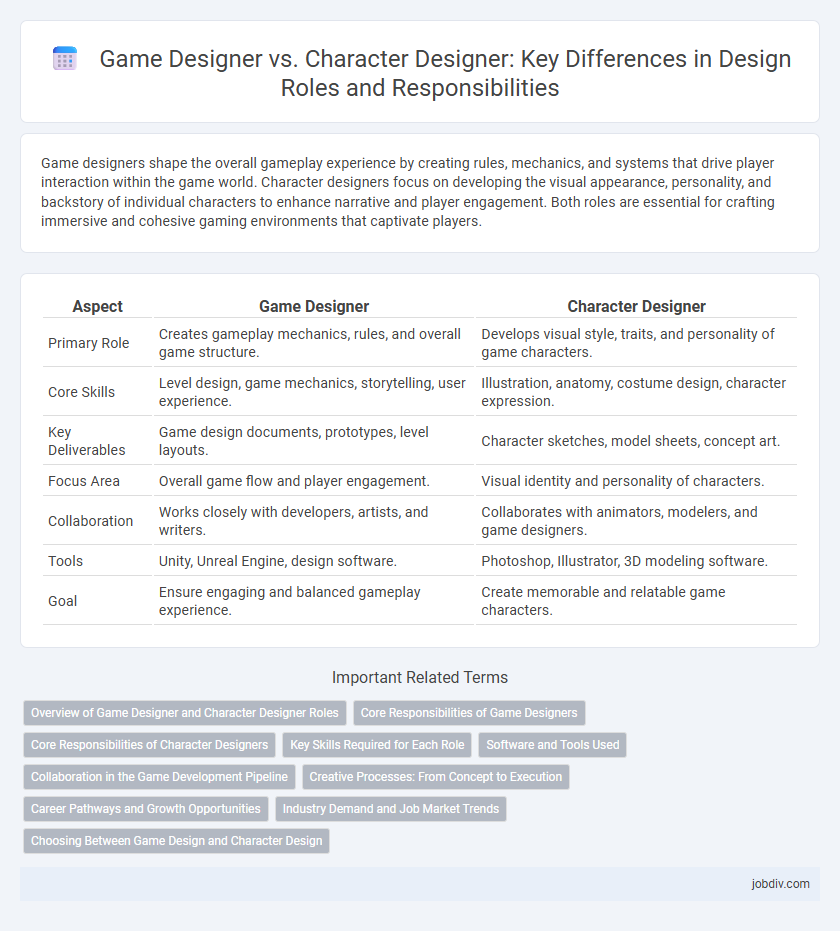Game designers shape the overall gameplay experience by creating rules, mechanics, and systems that drive player interaction within the game world. Character designers focus on developing the visual appearance, personality, and backstory of individual characters to enhance narrative and player engagement. Both roles are essential for crafting immersive and cohesive gaming environments that captivate players.
Table of Comparison
| Aspect | Game Designer | Character Designer |
|---|---|---|
| Primary Role | Creates gameplay mechanics, rules, and overall game structure. | Develops visual style, traits, and personality of game characters. |
| Core Skills | Level design, game mechanics, storytelling, user experience. | Illustration, anatomy, costume design, character expression. |
| Key Deliverables | Game design documents, prototypes, level layouts. | Character sketches, model sheets, concept art. |
| Focus Area | Overall game flow and player engagement. | Visual identity and personality of characters. |
| Collaboration | Works closely with developers, artists, and writers. | Collaborates with animators, modelers, and game designers. |
| Tools | Unity, Unreal Engine, design software. | Photoshop, Illustrator, 3D modeling software. |
| Goal | Ensure engaging and balanced gameplay experience. | Create memorable and relatable game characters. |
Overview of Game Designer and Character Designer Roles
Game designers create the overall gameplay experience by defining mechanics, rules, and player interactions to ensure engaging and balanced game flow. Character designers specialize in developing the visual style, personality, and backstory of characters, crafting unique and memorable avatars that enhance storytelling and player connection. Both roles collaborate closely to align game mechanics with character aesthetics, driving immersive and cohesive game environments.
Core Responsibilities of Game Designers
Game Designers primarily develop the overall gameplay mechanics, rules, and player experience, ensuring balanced challenges and engaging narratives. They collaborate closely with programmers and artists to implement interactive systems and define progression structures. Their core responsibilities also include prototyping game ideas, balancing game dynamics, and integrating user feedback to enhance playability.
Core Responsibilities of Character Designers
Character designers focus on creating visually compelling and unique characters that align with the game's story and artistic style. They develop detailed character sketches, expression sheets, and turnarounds to ensure consistency across animations and game environments. Their core responsibilities include collaborating with game designers to integrate character aesthetics with gameplay mechanics and narrative elements.
Key Skills Required for Each Role
Game designers require strong skills in storytelling, level design, and gameplay mechanics to create engaging player experiences, along with proficiency in software like Unity or Unreal Engine. Character designers focus on anatomy, visual creativity, and character development, mastering tools such as Adobe Photoshop and ZBrush to craft compelling and believable characters. Both roles demand collaboration and problem-solving abilities but differ significantly in their core creative and technical skill sets.
Software and Tools Used
Game designers primarily use software like Unity, Unreal Engine, and Blender to develop game mechanics, level designs, and interactive elements. Character designers rely on tools such as Adobe Photoshop, ZBrush, and Autodesk Maya to create detailed character models, textures, and concept art. Both roles often collaborate using project management tools like Jira and Trello to streamline development workflows.
Collaboration in the Game Development Pipeline
Game Designer and Character Designer collaborate closely in the game development pipeline to ensure cohesive gameplay and visual storytelling. Game Designers outline mechanics and player experience, while Character Designers create appealing and functional characters that align with the game's narrative and style. Effective communication between both roles enhances overall game quality by integrating character abilities seamlessly into game mechanics.
Creative Processes: From Concept to Execution
Game designers develop the overall gameplay mechanics, rules, and story arcs, integrating player experience into a cohesive system. Character designers specialize in creating visually compelling and emotionally resonant characters, focusing on anatomy, personality, and backstory through detailed sketches and turnarounds. Both roles collaborate closely, iterating from initial concepts to final execution to ensure consistency and engagement within the game's universe.
Career Pathways and Growth Opportunities
Game designers focus on creating overall gameplay mechanics, storylines, and interactive experiences, offering career growth through roles like lead designer, creative director, or production manager. Character designers specialize in developing unique, visually compelling characters, with advancement opportunities in senior design roles, art direction, or character animation supervision. Both fields demand strong collaboration skills and provide pathways into related sectors such as user experience design and multimedia storytelling.
Industry Demand and Job Market Trends
Game designers and character designers both play crucial roles in the gaming industry, but current job market trends show higher demand for game designers due to their broader skill set in gameplay mechanics, user experience, and level design. Character designers are sought after primarily in studios focused on art-intensive projects, animated games, and franchises with strong narrative-driven content. Industry reports indicate a growing need for multidisciplinary game designers who can collaborate across art, programming, and storytelling to meet evolving player expectations and emerging technologies like VR and AR.
Choosing Between Game Design and Character Design
Choosing between game design and character design depends on your passion for overall gameplay mechanics versus visual storytelling. Game designers focus on crafting engaging user experiences, game rules, and system balance, while character designers emphasize creating compelling visual identities and personalities for in-game characters. Understanding your strengths in interactive systems versus artistic expression helps determine the ideal career path in the gaming industry.
Game Designer vs Character Designer Infographic

 jobdiv.com
jobdiv.com